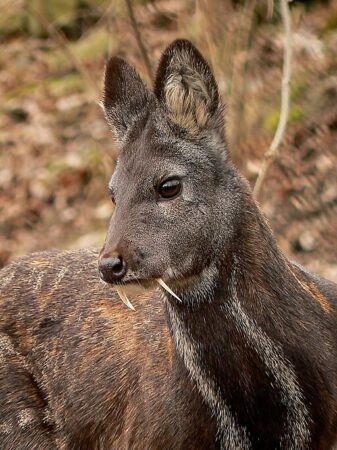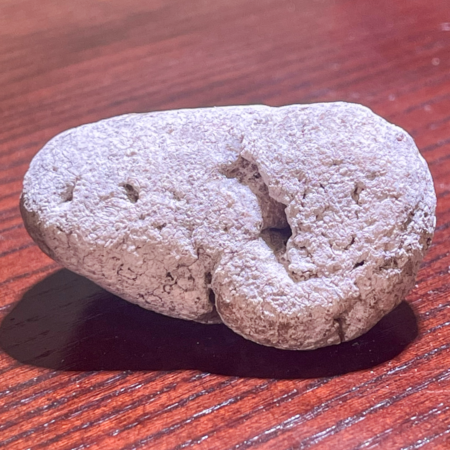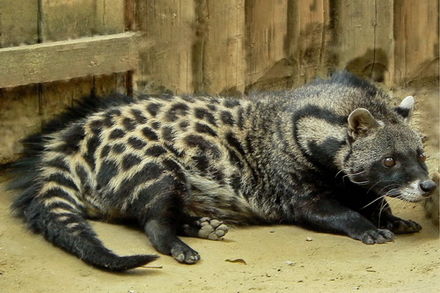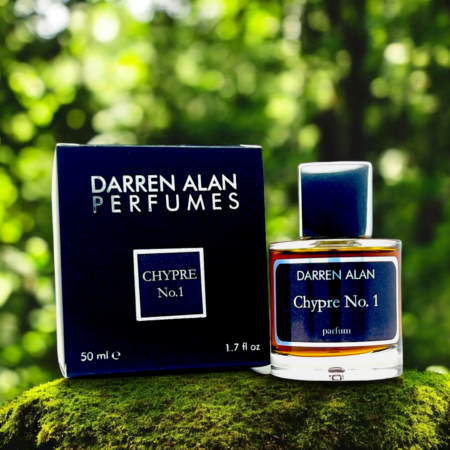Synthetic Animalic Mouillettes via Darren Alan©
“What are animalic notes and why are they in my perfume?” You may have heard the term “animalic” when referring to fragrance notes and may be asking yourself this very question. The term “animalic” refers to aromatic compounds used in perfumery that lend a note reminiscent of the natural musks emitted by certain animals. Animalic materials have played a significant role in perfumery for centuries. Prized for their unique scent profiles and fixative properties, these materials were traditionally derived from various animal sources, including deer musk, ambergris, castoreum, and civet. They add nuance to fragrances that can help modern humans reconnect with nature’s primal and feral aspects.

Darren Alan of Darren Alan Perfumes©
Animalic notes enhance depth, warmth, and sensuality in fragrances. They also provide fixative effects, helping to prolong the scent’s longevity on the skin. Moreover, animalic materials introduce a certain “dirtiness” to a perfume, offering a welcomed contrast to cleaner, fresher notes. When used judiciously and with expertise, these ingredients can create a stunning backdrop for a perfume composition. They provide warmth, contrast, complexity, and a sensual, unwashed skin nuance that evokes carnal exchanges, resulting in an almost pheromone-like magnetic allure.

Napoleon Quote via Darren Alan© (Josephine Bonaparte was said to douse herself in a custom Houbigant perfume which had strong notes of musk and civet)-Michelyn
Historically, animalic ingredients were harvested directly from animals, often through cruel methods. However, due to ethical concerns, conservation efforts, and the availability of convincing synthetic alternatives, perfumers can now replicate the scent profiles of these ingredients. So, how do we achieve this? Here are some insider tips from my perfumer’s bench:

Siberian Musk Deer via Wikimedia Commons
Let’s start with Deer Musk. Deer Musk adds a warm, sensual undertone to perfumes and has been used in perfumery for centuries. Traditionally, a gland called the musk pod was extracted from the abdomen of the male Musk Deer, cleaned, dried, and processed by perfumers. The internal contents (grains) of this gland were then soaked in alcohol for at least a year to create a tincture, which was subsequently added to perfumes to enhance their scent. However, modern perfumers rarely use this practice, as the Musk Deer is now an endangered species protected under the Convention on International Trade in Endangered Species (CITES). So, how do perfumers replicate the Musk Deer’s scent today? We do so on a molecular level.
I have a vintage Musk Deer tincture that I don’t use in my perfumes but rather keep in my reference material library. Over the years, I have studied the many facets of this material not only with my nose but also scientifically, using gas chromatography-mass spectrometry (GCMS). This laboratory process analyzes a material on a molecular level to create an “olfactory fingerprint” of the volatile scent molecules that compose its odor profile. I can then rebuild that raw material from scratch using synthetic molecules as building blocks to recreate the original scent.

Synthetic Musk Mouillettes by Darren©
Fortunately, modern perfumers have access to amazing synthetic molecules developed by leading raw material manufacturers in the fragrance industry. I utilize a blend of these raw materials to create my synthetic Deer Musk Replacer. Some key materials I incorporate are L-Muscone and Muscarome. These synthetic materials contain some of the same molecules found in the male Musk Deer. They exhibit warm, powdery musk notes that provide an elegant lift and diffusion. L-Muscone lasts several weeks on a perfume blotter, contributing to its long sillage and tenacity. Muscarome contains Musk Ketone along with other molecules to deliver a sparkling and powdery effect on the skin. Musk Ketone is the only classic nitro-musk still available in the modern perfumer’s palette, contributing a sweet, powdery nuance with a warm, fur-like undertone.

Found White Ambergris rom Scotland via Darren Alan’s collection©
Ambergris is renowned for its almost mythical fame and is known by various names, including floating gold, gray amber, and musk of the sea. It offers a marine, salty-sweet aroma with mineral undertones. Ambergris originates from sperm whales, specifically in about 1% of cases where intestinal irritation occurs due to squid beaks ingested while feeding. To safely expel the beaks, the whale’s digestive tract forms a waxy coating around them. This waxy mass floats on the water’s surface for months or years, undergoing a natural curing process from the sun and saltwater. As it floats, it develops a scent reminiscent of the sea—salty, marine, animalic, with subtle iodine hints.

Ambergris accord Mouillettes by Darren©
Due to its rarity and expense, many perfumers create a synthetic ambergris accord using various molecular components to replicate its unique fragrance. Some of my favorite materials for creating this accord include Ambroxide and Ambrinol, which are found naturally in genuine ambergris and are responsible for much of its signature scent. They can also be produced synthetically and have become common in modern perfumery. In addition to providing a marine, aquatic character, these materials enhance a perfume’s projection and longevity.

American Beaver via Wikimedia Commons
Castoreum is valued in perfumery for its warm, leathery, and animalic notes, adding depth and complexity to fragrances. This unique ingredient is traditionally obtained from the castor sacs of beavers, located near their anal glands, and was historically harvested from beavers trapped for their fur. In its pure form, castoreum has a strong, musky scent with phenolic hints of birch tar and vanilla, influenced by the beaver’s diet of bark and leaves. When properly processed and diluted, it transforms into an elegant ingredient that provides rich amber and leather-like undertones to perfume compositions. In modern perfumery, natural castoreum has largely been replaced by synthetic alternatives; however, some luxury perfume houses still use small quantities of this natural material. Castoreum is particularly effective in leather accords and amber fragrances, adding a warm, golden shimmer to explore.

Mouillettes of Castoreum synthetics accords: benzoic acid, acetophenone, p-ethyl phenol, ortho-cresol, and guaiacol©
Perfumers looking for animal-free castoreum can reconstruct it from a mélange of various materials, including benzoic acid, acetophenone, p-ethyl phenol, ortho-cresol, and guaiacol. By adjusting the ratios of these ingredients, the perfumer can manipulate the outcome based on their preference. Do you want your castoreum accord to be more leathery or more medicinal? More vanillic or more tar-like? I have several different versions of castoreum accords in my collection, each tailored to address specific requirements in a composition.

African Civet via Wikipedia
Civet musk is a material extracted from a paste-like secretion of the anal glands of the civet, a mammal related to the mongoose and found in parts of Asia and Africa. The aroma of the civet is pervasive and musk-like, with a slightly urinous and feral quality. The scent profile of civet varies based on several factors, including the civet’s diet, its living conditions, and the stress levels it experiences. Elevated stress hormones can negatively impact the odor of the civet, leading to an overly fecal scent profile that many perfumers find undesirable for fine fragrance.

Civet Mouillettes by Darren©
Modern perfumers can access numerous synthetic molecules, allowing us to create a convincing civet replacer without using animal materials. Some of my favorite ingredients for crafting a beautiful civet accord include Civetone, an aromatic ketone naturally occurring in genuine civet secretions and is responsible for the characteristic odor of civet. It is often combined with myristic acid, which helps to round out and contribute to the fatty, waxy scent profile of authentic civet. Skatole and Indole are useful additions but must be used with caution. These aromatic compounds are found not only in civet musk but are responsible for the unpleasant odor associated with halitosis (bad breath) and feces. Indoles add an untamed, feral nuance to civet. However, if used excessively, they can easily overwhelm and disrupt the delicate balance that the perfumer seeks to achieve.
While some animalic materials can be used as fixatives in a perfume on their own—such as an ambergris or castoreum accord—I believe these materials truly excel when artfully combined. This approach provides a warm, animalic, and textural base for more complex perfumes, such as Chypres.-Darren Alan, Contributor
All photos are owned by Darren Alan Perfumes and Pure Skin Formulations unless otherwise stated.
Darren Alan is a Contributor for www.cafleurebon.com. Darren is the owner, perfumer, and founder of Darren Alan Perfumes and Pure Skin Formulations, LLC. Darren began studying perfumery in 1994. He has been working in the personal care industry since 2005. Visit his shop at www.darrenalan.com
Darren Alan joins Michael Schrammel of For The Scent of It as contributors for Notes from the Lab. Darren will also be joining our team as our Notes and Ingredients contributor.

Chypre No. 1 Parfum via Darren Alan
Chypre No.1 by Darren Alan Perfumes takes a page from the great vintage perfumes of the past and combines notes of deer musk, civet and ambergris to create a harmonious blanket of gentle animalics that provides a luxurious structural foundation upon which a classic unisex Chypre is then constructed.
Top Notes: Bergamot, Lemon, Orange, Orange Blossom; Heart Notes: Rose de Mai, Jasmine, Carnation, Ylang-Ylang, Spices, Herbs; Base Notes: Labdanum, Oakmoss, Deer Musk Accord, Civet Accord, White Ambergris, Sandalwood, Patchouli, Incense Resins, Vanilla, Orris Butter
As a thank you for enjoying Darren’s Animalic Notes for our Notes From the Lab Series, Darren Alan Perfumes is offering a 50 ml bottle of Chypre No. 1 for one registered reader in the USA. You must register or your entry will not count. To be eligible please leave a comment telling us what you enjoyed most about Darren’s notes from the Lab the Animalic Notes in Perfumery. Winner must have an address in the USA. Draw closes 11/13/20242024
Please like The Series on Facebook here and your comment will count twice.
Read his Profile in American Perfumery here
Please visit Darren Alan Perfumes here AND SUPPORT OUR ARTISAN PERFUMERS
Follow us on Instagram @cafleurebonofficial @darren_alan_perfumes
This is our Privacy and Draw Rules Policy
We announce the winners only on our site and on our Facebook page, so like CaFleureBon and use our blog feed…or your dream prize will be just spilled perfume.

